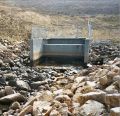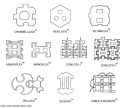Riprap and Concrete Blocks Examples: Difference between revisions
No edit summary |
No edit summary |
||
| Line 1: | Line 1: | ||
[[Category:Accounting for Energy Dissipation Outlet Works]] | |||
---- | |||
<!-- Add body paragraphs here --> | <!-- Add body paragraphs here --> | ||
The riprap apron is one of the most common forms of outlet protection on small dams. The riprap apron is typically a flared transition constructed at zero grade for a distance downstream that is related to the conduit diameter. Although the riprap apron provides relatively little energy dissipation, it can provide very effective erosion protection at the conduit outlet by armoring the turbulent transition area. The key design parameters of the riprap apron are apron length, apron width, riprap thickness, and riprap size. | The riprap apron is one of the most common forms of outlet protection on small dams. The riprap apron is typically a flared transition constructed at zero grade for a distance downstream that is related to the conduit diameter. Although the riprap apron provides relatively little energy dissipation, it can provide very effective erosion protection at the conduit outlet by armoring the turbulent transition area. The key design parameters of the riprap apron are apron length, apron width, riprap thickness, and riprap size. | ||
| Line 12: | Line 9: | ||
File:RC1.jpg|Transitional riprap apron downstream for a type VI stilling basin to prevent scour. | File:RC1.jpg|Transitional riprap apron downstream for a type VI stilling basin to prevent scour. | ||
File:RC2.jpg|The grouted riprap has performed well although some of the larger rocks in the foreground are displaced immediately downstream of the concrete apron. | File:RC2.jpg|The grouted riprap has performed well although some of the larger rocks in the foreground are displaced immediately downstream of the concrete apron. | ||
File:RC3.jpg|Gabion-lined basin. The earthen basin was used to facilitate construction access and has been removed. | File:RC3.jpg|Gabion-lined basin. The earthen basin was used to facilitate [[construction]] access and has been removed. | ||
File:RC4.jpg|Armorflex Blocks in downstream channel. | File:RC4.jpg|Armorflex Blocks in downstream channel. | ||
File:RC5.jpg|Outlet protection using Articulated Concrete Blocks and A-Jacks®. | File:RC5.jpg|Outlet protection using [[Articulated Concrete Blocks]] and A-Jacks®. | ||
File:RC6.jpg|Outlet protection using Articulated Concrete Blocks and A-Jacks®. | File:RC6.jpg|Outlet protection using Articulated Concrete Blocks and A-Jacks®. | ||
File:RC7.jpg|Examples of Articulated Concrete Block (ACB) revetment systems. | File:RC7.jpg|Examples of Articulated Concrete Block (ACB) revetment systems. | ||
Revision as of 03:28, 2 December 2022
The riprap apron is one of the most common forms of outlet protection on small dams. The riprap apron is typically a flared transition constructed at zero grade for a distance downstream that is related to the conduit diameter. Although the riprap apron provides relatively little energy dissipation, it can provide very effective erosion protection at the conduit outlet by armoring the turbulent transition area. The key design parameters of the riprap apron are apron length, apron width, riprap thickness, and riprap size.
Note: The content on this page was originally created as part of DamOutletWorks.org (DOWL, 2018). It has subsequently been updated and reformatted as part of the Dam Safety Toolbox.
Revision ID: 4761
Revision Date: 12/02/2022













